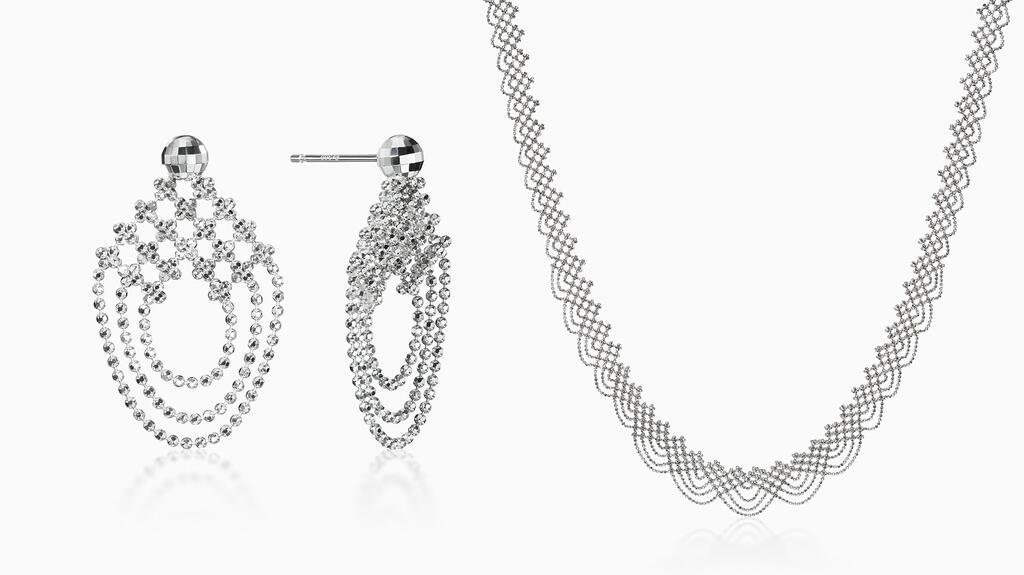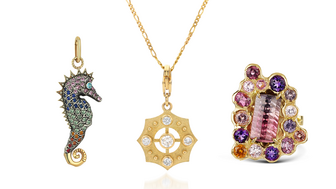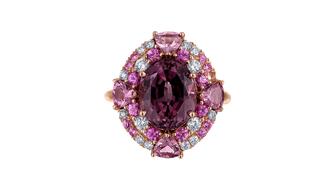Q&A: 8 Questions With Anglo American’s Benny Oeyen
The executive talked about the importance of self-purchasers and how fuel cell electric vehicles are going to fuel demand for platinum.

We discussed the importance of people buying platinum jewelry as a little treat for themselves, how much consumers really care about sustainability, and the price of platinum, which sat at $964 an ounce as of press time.
The interview has been edited for length and clarity.
Please also note, this interview was conducted prior to the news that BHP Group Inc. had made an unsolicited, and ultimately rejected, bid for Anglo American that would have involved Anglo spinning off its platinum business, as well as its iron ore operations in South Africa.
Michelle Graff: Anglo now has this partnership with Stuller for supplying responsibly mined platinum grain to its retailers. For me, this seems like a tipping point, of sorts, for sustainability.
Sometimes when we’re talking sustainability, we know customers in New York or San Francisco might feel that way but it’s not always representative of the rest of the country. When I saw that Stuller is doing this, I thought there must be a real call for it. Can you speak to that?
Benny Oeyen: Yeah, we think there was a real call for it. The platinum group metals, and specifically platinum, they’re kind of magic metals. They’re very young.
MG: What do you mean by young?
BO: They were discovered in mid-18th century, in 1750. In the world of metals, that’s … very young, very pure. It means we haven’t yet discovered many of the things you can do with them. And we’re discovering now more and more that they’re a key part of the “green” transition. So that’s a sustainability angle. We can talk about that later.
Secondly, also we think we have a sustainability [angle] to talk about how we mine our metals. We hold ourselves to the highest standards and we feel that this story is not told in the market. The bulk of the customers don’t [know about it].
We were like OK, we look at different markets, markets have different structures. The U.S. market, to our big surprise, is actually a very fragmented market. In order to then communicate, etc., you need to have an entrance door to this mass market and not communicate with all of them separately. So, we started engaging with [Stuller]. And you know, a corporate relationship is a bit like a personal relationship. You start dating a little bit and figure it out, and we figured out that we like each other. We work very well together.
To answer your question more specifically on sustainability, I think it’s an underestimated story of what platinum and the platinum group metals can do for the world.
“The mentality of the ‘80s, like, just give me something that’s really nice and I don’t care how it’s made, etc. … that’s a bit gone.” — Benny Oeyen, Anglo American
MG: Even though, as you mentioned, this market is fragmented, is sustainability something a lot of consumers are after today, whether they’re in Texas, Florida, Minnesota, California, or Pennsylvania?
BO: They are and especially in America because the American consumer is very educated, especially the younger ones, right? The mentality of the ‘80s, like, just give me something that’s really nice and I don’t care how it’s made, etc., … that’s a bit gone.
[Now, consumers] want to know a little bit about, where’s the product coming from, are we not destroying the Earth, etc. We feel there is a big field open there and I think we have a good story to tell in two vectors.
One is that platinum can help in the whole sustainability businesses in order to build a future energy system, that’s one, and secondly, the way we mine.
So, at Anglo American, we hold ourselves accountable to the highest mining standard, it’s called IRMA. This is the most severe one. It’s one that many miners don’t like because it’s an NGO one and many would like to make their own but we put that as our standard that we want to be measured against.
We now have several mines that are already IRMA certified, and we want [to get the whole group certified].
“The American market definitely still has a lot of potential for jewelry. There was this myth that young people don’t care about jewelry anymore. That is not showing in the numbers.” — Benny Oeyen, Anglo American
MG: I want to talk a little bit too about Anglo American’s relationship with Platinum Guild International USA. Anglo American is now the sole sponsor of PGI USA. What makes Anglo so confident in the future of jewelry here? And when you look at jewelry, do you see growth in bridal or what we would call fashion, meaning non-bridal, jewelry?
BO: I think that the American market definitely still has a lot of potential for jewelry. There was this myth, which I now call an urban myth, 10 to 15 years ago, that young people don’t care about jewelry anymore. They want to take a cruise or a trip around the world or a romantic weekend in Paris rather than jewelry. That is not showing in the numbers.
MG: No. Jewelry absolutely exploded during the pandemic.
BO: Yep, there you go. We see a lot of potential there.
Secondly, we see a lot of potential for platinum because jewelry used to be very traditionally yellow and now there’s a lot of people who like the other colors. And we say if you want something that looks like platinum, it’s better to buy the real thing. We think if we tell our story with platinum, we have a lot of potential there.
And then to answer your question whether it’s bridal or whether it’s fashion, you know, you cannot convince people to get married with advertising campaigns. But you can convince people to self-purchase.
You don’t have to wait for a big occasion like a marriage; you can also be super-happy and buy something for yourself because you feel good about it. And there we think there’s a very big untapped potential still.
So, very concretely, we think bridal is like the foundation. It will always be there. And then on top of bridal, we can build the house of fashion, “Platinum Born” for example, but many other things we can do.
That is really how we see it.

MG: I want to talk a little bit about price. Metal prices are always of interest to our readers. The price of platinum has been below the price of gold for some time now. Where do you see the platinum price going in the future?
BO: Listen, traditionally platinum has been higher than gold because it’s a diversified metal. It has the same usage as gold, for example store of value and jewelry, but then it has a lot of other [uses].
The main application [of platinum has historically been] in catalytic converters in internal combustion engine cars and then we had the whole story when the EVs (electric vehicles) started popping up … and [many believed] EVs are going to take over the market. And that [expected decline in future platinum demand] is now priced in the platinum price already.
I have worked over 20 years in the car business and in comparison, only six years in the mining business so I can speak with a little bit of authority on cars—believe me, EVs are not going to take over the market.
They’re going to take a big chunk, but they’re not going to be 100 percent of the market.
MG: Why?
BO: Because they’re just not practical for many people. There are some physical limitations [such as limited range and the time and infrastructure required to recharge them].
We think fuel cell electric vehicles [are the future] because a fuel cell electric vehicle is an electric car that drives like an electric car but the consumer behavior’s can be like a traditional gas/internal combustion engine car.
[In a fuel cell electric car], electricity is made on the spot on board by mixing hydrogen with outside air in a device called the fuel cell.
MG: So where does the platinum fit into this?
BO: In two parts; the first is to split water, it’s called electrolysis. So, H2O is water, and you want to split the “O” off. The device that does that is called an electrolyser, and one of the main types of electrolyser technology contains platinum. Platinum makes the chemical reaction when you put electricity in it so that oxygen is split off. That’s one part of the hydrogen story where platinum is present.
And so now you have pure hydrogen, and you want electricity again. This is where a fuel cell comes in. So, we mix [the hydrogen] again with oxygen in an environment like a fuel cell where there is platinum to help the chemical reaction to release electricity. It’s essentially the same process as the electrolyser but in reverse. So, there you put electricity in and you have hydrogen; now, you take hydrogen, mix it with oxygen, you take electricity out.
In a fuel cell, there is a lot of platinum. Without platinum as a catalyst, it simply doesn’t work.
MG: How many fuel cell vehicles are there on the road today?
BO: Not very many. Toyota has a Mirai, Hyundai has Nexo, and then are already four [hydrogen fuel cell vehicle] manufacturers in China. And BMW is now starting to look at it with the X5.
The Achilles Heel is that you need a hydrogen refueling station. We’re facing there a chicken-and-egg situation. If you talk to the OEMs, the car manufacturers, [and ask], why don’t you make more fuel cell cars? They say because there are no stations. If you talk to Marathon or Texaco or Shell [and ask], why don’t you make more stations, it’s because there are no cars.
It’s a classic chicken-and-egg. That will be broken by semis [that are used to transport goods long distances].
I’m from Belgium, so I have to give you a beer example. [If you drive] from Budweiser in St. Louis to Denver or something like that with a big truck, if you do that with batteries, you will have mainly batteries in the truck and a few pints of beer. And that’s where fuel cells are coming in.
There’s a lot of talks with the big trucking companies, Freightliner, Mack, Daimler. Then there’s Nikola, which is a truck manufacturer, a new startup that will make fuel cell trucks.
With these trucks along the big highways will come the hydrogen stations. It’s like diesel to the United States. United States doesn’t have passenger car diesel but there’s some big pickup trucks that drive with diesel. When I lived in Michigan, in my neighborhood gas station there was no diesel but, on the highways, I-75, I-94, [there was diesel]. It will be the same with hydrogen.
And that will create a lot of demand [for platinum].
The Latest

As the shopping mall model evolves and online retail grows, Smith shares his predictions for the future of physical stores.

The trade show is slated for Jan. 31-Feb. 2 at The Lighthouse in New York City's Chelsea neighborhood.

January’s birthstone comes in a rainbow of colors, from the traditional red to orange, purple, and green.

How Jewelers of America’s 20 Under 40 are leading to ensure a brighter future for the jewelry industry.

The annual report highlights how it supported communities in areas where natural diamonds are mined, crafted, and sold.


Footage of a fight breaking out in the NYC Diamond District was viewed millions of times on Instagram and Facebook.

The supplier has a curated list of must-have tools for jewelers doing in-house custom work this year.

Roseco’s 704-page catalog showcases new lab-grown diamonds, findings, tools & more—available in print or interactive digital editions.

The Signet Jewelers-owned store, which turned 100 last year, calls its new concept stores “The Edit.”

Linda Coutu is rejoining the precious metals provider as its director of sales.

The governing board welcomed two new members, Claire Scragg and Susan Eisen.

Sparkle with festive diamond jewelry as we celebrate the beginning of 2026.

The master jeweler, Olympian, former senator, and Korean War veteran founded the brand Nighthorse Jewelry.

In its annual report, Pinterest noted an increase in searches for brooches, heirloom jewelry, and ‘80s luxury.

Executive Chairman Richard Baker will take over the role as rumors swirl that a bankruptcy filing is imminent for the troubled retailer.

Mohr had just retired in June after more than two decades as Couture’s retailer liaison.

Shekhar Shah of Real Gems Inc. will serve as president of the Indian Diamond & Colorstone Association in 2026.

This year’s good luck charm features the mythical horse Pegasus, and is our first Piece of the Week of the new year.

As part of the leadership transition, Sherry Smith will take on the role of vice president of coaching strategy and development.

It marks the third time the country has headed the Kimberley Process. Ghana will serve as vice chair.

The new Bulova x Stetson designs highlight two animals often associated with the American West—the bison and the Texas Longhorn.

Its residency at Yamron Jewelers will run through May 2026.

From influential executives to innovative designers, we pay tribute to the people we said goodbye to this year.

The retailer is expanding into areas with large Indian and South Asian populations.

The Italian brand has opened its first flagship amid the peaks of the Dolomites in Madonna di Campiglio, Italy.

The new curation at the Natural History Museum of Los Angeles County showcases rare gem and mineral specimens in their uncut, natural state.

The couple pleaded guilty to concealing at least $127 million in cash transactions at its precious metals businesses.





























